Solution Selling vs Product Selling: Which Is Best for You?
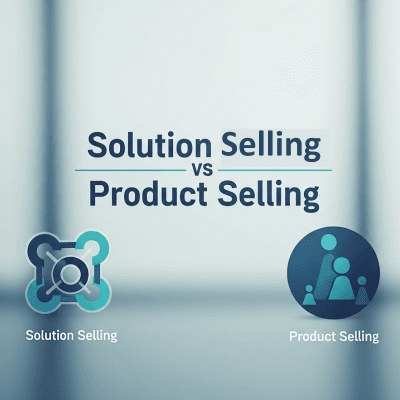
Add a Table of Contents
TL;DR
|
Today’s buyers aren’t just looking for bells and whistles; they’re looking for answers. If you’re in B2B SaaS, you’ve probably noticed that rattling off features and pricing isn’t enough to move deals forward. Modern decision-makers want to feel understood. They expect solutions tailored to their unique pain points, not just a list of product specs.
That’s why it’s time to rethink the way we sell. As per Harvard Business Review, the traditional approach, pitching features and hoping something sticks, is quickly becoming outdated. In competitive markets, understanding the difference between solution selling vs product selling can make or break your sales strategy.
Let's break down the two approaches, compare their strengths, and help you decide which one aligns best with your product, customer, and growth goals.
What is Solution Selling?
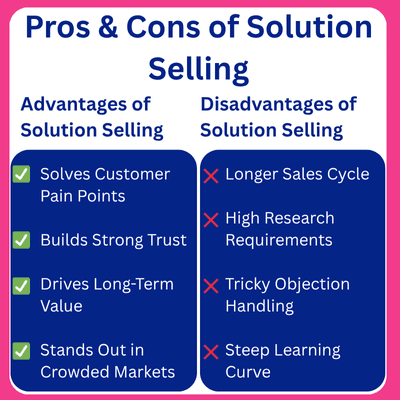
Solution selling is a consultative approach that centers on uncovering a customer’s specific problems and offering personalized solutions, rather than simply showcasing product features. It requires a deeper understanding of the buyer’s goals, workflows, and pain points, making the sales conversation more about value and less about product specifications.
For example, a SaaS company may customize its CRM (Customer Relationship Management) to streamline a sales team’s workflow and reduce lead leakage.
What Are the Advantages of Solution Selling in Modern Markets?
Solution sales process offers transformative benefits, especially in competitive markets where customer-centricity is key.
Resolves Customer Pain Points Effectively: By identifying and addressing the buyer's unique needs, solution selling provides tailored support.
Strengthens Customer Trust: It establishes sales reps as genuine partners invested in buyers’ success.
Focuses on Long-Term Value: This approach often boosts customer lifetime value through a strong return on investment.
Differentiates in Crowded Markets: Solution selling highlights unique offerings that competitors might overlook.
Where Does Solution Selling Fall Short?
While solution selling is impactful, it comes with its share of challenges.
Longer Sales Cycles: The need for deep discovery and customization often slows down the process compared to traditional product selling.
High Research Demand:Sales reps must invest time in understanding each buyer’s unique business context, which can be resource-intensive.
Complex Objection Handling: Addressing detailed concerns, especially around pricing or ROI, requires advanced communication and consultative skills.
Steeper Learning Curve: Without proper sales enablement and training, reps may struggle to implement solution selling effectively.
What is Product Selling?
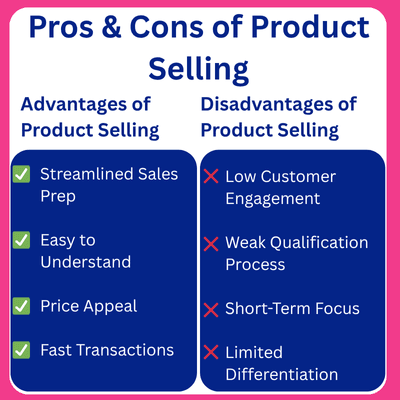
Product selling is a traditional sales approach that emphasizes the features, specifications, and price of a product. It focuses on what the product is rather than what it does for the customer. This method is especially common in:
Retail and eCommerce
Consumer electronics
Fast-moving tech products
For example, a smartphone brand might promote its latest model by highlighting its camera quality, battery life, and price, with little emphasis on the buyer’s specific needs.
What Are the Benefits of Product Selling for Fast-Moving Goods?
For fast-moving goods and straightforward sales processes, product selling delivers distinct advantages.
Streamlined Sales Preparation: Sales reps can utilize a consistent, pre-crafted pitch, reducing effort and time invested.
Emphasizes Ease of Understanding: Highlighting clear product features makes the offering accessible to even non-technical buyers.
Works Well for Price-Sensitive Markets: Customers can quickly evaluate cost advantages.
Immediate Sales Gratification: The simplicity of this approach facilitates quicker transactions and faster revenue gains.
How Can Product Selling Hold You Back?
While product selling is straightforward and effective for certain markets, it comes with several limitations that can restrict long-term growth:
Limited Customer Engagement: Focusing only on the product's features overlooks the customer’s pain points, making the experience feel impersonal.
Weak Qualification Process: Without deep discovery, sales representatives may miss key buyer needs or waste time on poor-fit prospects.
Short-Term Focus: Emphasizing quick wins often comes at the cost of building lasting customer relationships.
Difficulty in Market Differentiation: Competing on specs and price alone can be risky in saturated or highly competitive markets.
Solution Selling vs Product Selling: What Are the Major Differences Between the Two Across the SaaS Sales Journey?
In SaaS sales, understanding the difference between solution and product selling is crucial. Each approach takes a different path through the sales process, shaping how sales teams communicate value, address challenges, and ultimately close deals more successfully.
Let’s explore how product-focused and solution-oriented selling strategies behave differently at each stage of the B2B SaaS sales process.
Stage 1: How Do Product Selling and Solution Selling Approaches Differ During Discovery and Lead Qualification?
The discovery and qualification stage sets the tone for the entire sales process. It’s where sales teams determine whether a prospect aligns with their Ideal Customer Profile (ICP) and is worth pursuing further.
Product Selling Approach:
Goal: Quickly gauge interest based on features and pricing
Approach: Lead with product specs, highlight cost advantages
Mindset: “Does this person want what I’m selling?”
Example Discovery Question:
“We offer a low-cost CRM with automated call tracking and pipeline visibility. Are you in the market for a tool like this?”
Solution Selling Approach:
Goal: Understand the prospect’s business pain before positioning the product
Approach: Ask targeted questions to uncover challenges
Mindset: “Can we solve a meaningful problem for them?”
Example Discovery Question:
“Can you walk me through your biggest workflow bottlenecks when it comes to sales reporting or pipeline tracking?”
Stage 2: How Do Product Selling vs Solution Selling Shape the Initial Pitch and Value Proposition?
This stage is where the sales rep communicates the value of their offering, but how they do that varies greatly depending on the selling approach.
Product Selling Approach:
Goal: Clearly present product features and pricing to all prospects
Approach: Use a structured, one-size-fits-all pitch focused on technical specs
Mindset: “Here’s what we offer and why it’s better than competitors.”
Example Product-Led Pitch:
“We offer a CRM that includes task automation, team dashboards, and detailed reporting, all for just $30 per seat.”
Solution Selling Approach:
Goal: Align product capabilities with the prospect’s specific pain points
Approach: Customize the pitch using insights gathered during discovery
Mindset: “How can we help solve their business challenges more effectively?”
Standard Sales Pitch Example:
“You mentioned lost leads during SDR handoffs. Our CRM automates lead assignments and follow-ups, helping teams close gaps and increase win rates.”
Stage 3: How Do Product and Solution Selling Strategies Impact the Product Demo Stage?
At this stage, the product comes to life. How it’s showcased depends entirely on whether the rep is selling features or solutions.
Product Selling Approach:
Goal: Highlight core functionality and usability
Approach: Deliver a standardized demo focused on product capabilities
Mindset: “Let’s show them what the product can do.”
Demo Flow:
“Let’s start with the dashboard. From here, your team can create deals, run reports, and manage reminders, all in one place.”
Solution Selling Approach:
Goal: Demonstrate how the product solves the customer’s specific pain points
Approach: Tailor the product walkthrough to the use case uncovered during discovery
Mindset: “Let’s show them how this solves their problem.”
Demo Flow:
“Earlier, you mentioned reps wasting time on manual data entry. Here’s how our bulk automation tool streamlines that, freeing up hours each week for actual selling.”
Pro Tip: Tools like SmartCue help you make personalized, solution-oriented demos that are easy to execute. With SmartCue, sales reps can build interactive, guided product demos that align with each prospect’s unique use case, helping you move beyond generic walkthroughs and deliver value from the very first click.
Stage 4: How Do Product Selling and Solution Selling Tackle Pricing, Objections, and Negotiation?
At this stage, the conversation shifts toward commitment. However, how pricing and objections are handled can reveal whether you’re selling a product or a solution.
Product Selling Approach:
Goal: Present standard pricing and close based on features
Approach: Stick to fixed tiers, encourage upgrades or bundles
Mindset: “Here’s the price, let’s find the right fit.”
Example Stance:
“Our standard plan includes everything you need: five seats, reports, and integrations. Pricing is fixed at $49/user.”
Solution Selling Approach:
Goal: Align pricing with customer needs and perceived value
Approach: Adapt packages and frame the cost in terms of ROI
Mindset: “How can we structure this so it delivers value and fits their budget?”
Example Stance:
“If your team doesn’t need the marketing integrations, we can create a leaner plan that still solves your key pain points at $42/user.”
Product Selling vs Solution Selling: How to Choose the Right Approach for Your Business?
In today’s competitive sales landscape, one size doesn’t fit all. Choosing between selling solutions vs products can determine how effectively your team connects with potential buyers and closes deals. The key is knowing when each sales strategy makes the most impact.
When to Use Product Selling?
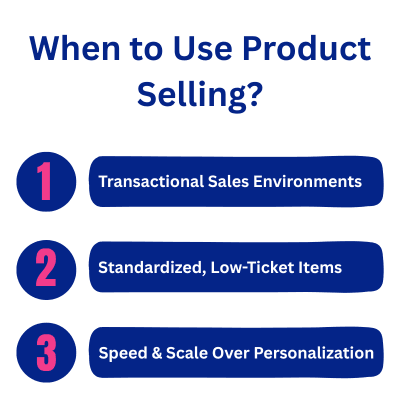
Product selling is a good fit when speed, simplicity, and volume take priority over deep customization or long sales conversations. It works best in situations where the product’s features speak for themselves and the buyer already understands what they need.
Use product selling when:
You're in a transactional sales environment where quick decisions are the norm.
You're offering standardized, low-ticket items that don’t require extensive discovery.
Speed and scalematter more than a tailored sales experience.
Industries like retail, eCommerce, and consumer electronics thrive on this approach, where the buyer is focused on specs, pricing, and availability rather than the value of your solution.
When to Use Solution Selling?
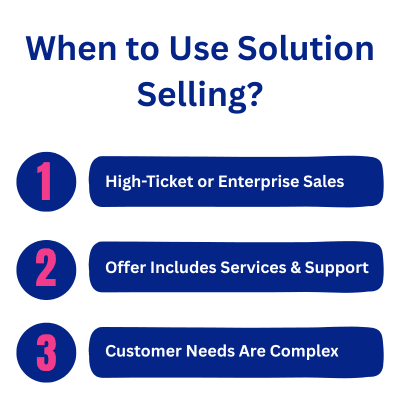
Solution selling is the right choice when your offering goes beyond just a specific product and requires understanding the buyer’s unique needs. It’s ideal for complex B2B environments where modern buyers expect a tailored, consultative experience rather than a one-size-fits-all pitch.
Use solution selling when:
You're selling high-ticket or enterprise-level products that involve multiple decision-makers.
Your offering includes consulting, implementation, or post-sale support.
The customer’s needs vary and require you to dive into the bigger picture before offering a solution.
Industries like SaaS, IT services, and enterprise software benefit most from this model.
Here, the sales journey involves more than just a demo; it’s about guiding the potential customer through a value-focused process with effective sales conversations. It also includes addressing sales objections and aligning on the best solution for long-term success.
What’s the SmartCue Advantage in Bridging the Gap Between Product and Solution Selling?
Whether you're leaning toward product selling or fully embracing a solution selling process, SmartCue empowers your sales team to do both better. Designed for modern B2B sales teams, SmartCue helps reps deliver personalized, value-driven demo experiences at scale.
No more static product tours or generic walkthroughs.
With SmartCue, you can tailor every demo to the buyer’s unique needs, turning feature showcases into consultative conversations that actually close. It’s not just about showing what your product does; it’s about proving what it solves.
From boosting engagement to shortening sales cycles, SmartCue bridges the gap between fast-paced feature selling and deep solution selling with ease.
Ready to make your demos your best differentiator? Start your 14-day free trial todayat SmartCue and unlock the future of personalized selling.
Conclusion
In today’s buyer-driven market, choosing the right sales approach isn’t just a tactic; it’s a strategic advantage. Whether you’re showcasing standout features or solving complex business challenges, the key lies in aligning your method with what your customers truly need.
Solution selling vs product selling isn’t a debate of which is better, but rather which is better for your buyer. By understanding where your prospects are in their journey and tailoring your approach accordingly, you’ll foster deeper trust, close deals more effectively, and create long-term value.
The future of sales belongs to teams that can flex between both models with confidence and deliver a sales experience that feels personal, relevant, and results-driven.
Frequently Asked Questions
What is the difference between selling a product and selling a solution?
Selling a product focuses on promoting specific features and benefits of an item. Selling a solution focuses on understanding a customer’s problem and offering a tailored answer that solves it, often beyond just the product itself.
What are the 4 types of selling methods?
The four main types of selling methods are transactional selling, solution selling, consultative selling, and provocative selling. Transactional selling focuses on quick sales, while the others emphasize understanding customer needs, offering tailored solutions, or challenging buyers to rethink their priorities.
What is a solution vs. a product?
A product is a tangible item or service offered for sale. A solution combines products, services, and expertise to address a specific customer problem or need, delivering measurable outcomes rather than just features.
Is solution selling more effective for B2B or B2C sales?
Solution selling often proves more effective in B2B contexts, where complex needs and long-term relationships are prioritized. However, B2C sales can also benefit from solution selling when addressing specific customer problems, resulting in increased customer satisfaction and loyalty.
What skills are essential for a successful solution seller?
Successful solution sellers possess strong communication, problem-solving, and analytical skills. They must understand customer needs deeply, build rapport, and tailor solutions accordingly. Additionally, adaptability and a solid grasp of industry trends are essential to navigate complex sales environments effectively.
Comments
Your comment has been submitted successfully!